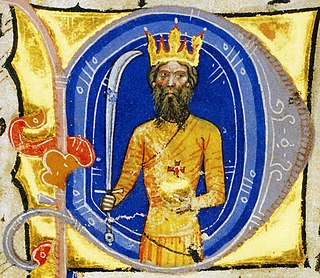
Attila, frequently called Attila the Hun, was the ruler of the Huns from 434 until his death in March 453. He was also the leader of a tribal empire consisting of Huns, Ostrogoths, Alans, and Bulgars, among others, in Central and Eastern Europe.
The 430s decade ran from January 1, 430, to December 31, 439.
The 450s decade ran from January 1, 450, to December 31, 459.

Year 434 (CDXXXIV) was a common year starting on Monday of the Julian calendar. At the time, it was known as the Year of the Consulship of Aspar and Areobindus. The denomination 434 for this year has been used since the early medieval period, when the Anno Domini calendar era became the prevalent method in Europe for naming years.
The 440s decade ran from January 1, 440, to December 31, 449.

Marcian was Roman emperor of the East from 450 to 457. Very little of his life before becoming emperor is known, other than that he was a domesticus who served under the commanders Ardabur and his son Aspar for fifteen years. After the death of Emperor Theodosius II on 28 July 450, Marcian was made a candidate for the throne by Aspar, who held much influence because of his military power. After a month of negotiations Pulcheria, Theodosius' sister, agreed to marry Marcian. Zeno, a military leader whose influence was similar to Aspar's, may have been involved in these negotiations, as he was given the high-ranking court title of patrician upon Marcian's accession. Marcian was elected and inaugurated on 25 August 450.
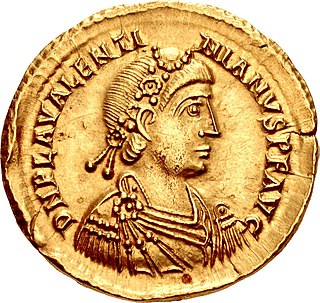
Valentinian III was Roman emperor in the West from 425 to 455. Made emperor in childhood, his reign over the Roman Empire was one of the longest, but was dominated by powerful generals vying for power amid civil wars and the invasions of Late Antiquity's Migration Period, including the campaigns of Attila the Hun.

Flavius Aetius was a Roman general and statesman of the closing period of the Western Roman Empire. He was a military commander and the most influential man in the Empire for two decades (433–454). He managed policy in regard to the attacks of barbarian federates settled throughout the West. Notably, he mustered a large Roman and allied (foederati) army in the Battle of the Catalaunian Plains, ending a devastating invasion of Gaul by Attila in 451, though the Hun and his subjugated allies still managed to invade Italy the following year, an incursion best remembered for the ruthless Sack of Aquileia and the intercession of Pope Leo I.
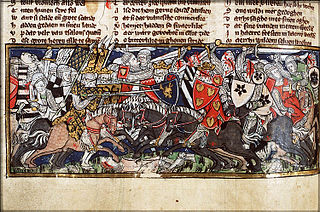
The Battle of the Catalaunian Plains, also called the Battle of the Campus Mauriacus, Battle of Châlons, Battle of Troyes or the Battle of Maurica, took place on June 20, 451 AD, between a coalition – led by the Roman general Flavius Aetius and by the Visigothic king Theodoric I – against the Huns and their vassals – commanded by their king Attila. It proved one of the last major military operations of the Western Roman Empire, although Germanic foederati composed the majority of the coalition army. Whether the battle was of strategic significance is disputed; historians generally agree that the Siege of Orleans was the decisive moment in the campaign and stopped the Huns' attempt to advance any further into Roman territory or establish vassals in Roman Gaul. However, the Huns successfully looted and pillaged much of Gaul and crippled the military capacity of the Romans and Visigoths. Subsequently thereafter Attila died only two years later in 453; after the Battle of Nedao (454), the coalition of the Huns and the incorporated Germanic vassals would begin to be dismantled.
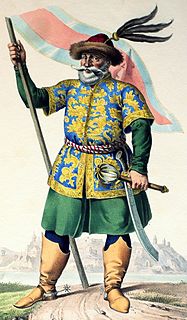
Bleda was a Hunnic ruler, the brother of Attila the Hun.
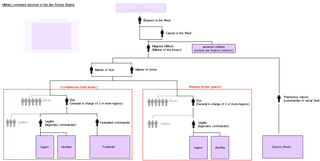
Magister militum was a top-level military command used in the later Roman Empire, dating from the reign of Constantine the Great. The term referred to the senior military officer of the empire. In Greek sources, the term is translated either as strategos or as stratelates.
Orestes was a Roman general and politician of Pannonian ancestry, who held considerable influence in the late Western Roman Empire.

Priscus of Panium was a 5th-century Eastern Roman diplomat and Greek historian and rhetorician.
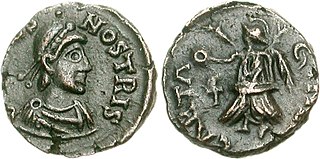
Bonifatius was a Roman general and governor of the diocese of Africa. He campaigned against the Visigoths in Gaul and the Vandals in north Africa. An ally of Galla Placidia, mother and advisor of Valentinian III, Bonifacius engaged in Roman civil wars on her behalf against the generals Felix in 427-429 and Aetius in 432. Although he defeated the latter at the Battle of Rimini, Bonifacius suffered a fatal wound and was succeeded by his son-in-law Sebastianus as patricius of the Western Roman Empire.
Rugila or Ruga, was a ruler who was a major factor in the Huns' early victories over the Roman Empire. He served as an important forerunner with his brother Octar, with whom he initially ruled in dual kingship, possibly a geographical division where Rugila ruled over Eastern Huns while Octar over Western Huns, during the 5th century AD.
Dengizich, was a Hunnic ruler and son of Attila. After Attila's death in 453 AD, his Empire crumbled and its remains were ruled by his three sons, Ellac, Dengizich and Ernak. He succeeded his older brother Ellac in 454 AD, and probably ruled simultaneously over the Huns in dual kingship with his brother Ernak, but separate divisions in separate lands.

Attila is a 2001 American television miniseries set during the waning days of the Western Roman Empire, in particular during the invasions of the Huns in Europe.
The history of the Huns spans the time from before their first secure recorded appearance in Europe around 370 AD to after the disintegration of their empire around 469. The Huns likely entered Western Asia shortly before 370 from Central Asia: they first conquered the Goths and the Alans, pushing a number of tribes to seek refuge within the Roman Empire. In the following years, the Huns conquered most of the Germanic and Scythian barbarian tribes outside of the borders of the Roman Empire. They also launched invasions of both the Asian provinces of Rome and the Sasanian Empire in 375. Under Uldin, the first Hunnic ruler named in contemporary sources, the Huns launched a first unsuccessful large-scale raid into the Eastern Roman Empire in Europe in 408. From the 420s, the Huns were led by the brothers Octar and Ruga, who both cooperated with and threatened the Romans. Upon Ruga's death in 435, his nephews Bleda and Attila became the new rulers of the Huns, and launched a successful raid into the Eastern Roman Empire before making peace and securing an annual tribute and trading raids under the Treaty of Margus. Attila appears to have killed his brother and became sole ruler of the Huns in 445. He would go on to rule for the next eight years, launching a devastating raid on the Eastern Roman Empire in 447, followed by an invasion of Gaul in 451. Attila is traditionally held to have been defeated in Gaul at the Battle of the Catalaunian Fields, however some scholars hold the battle to have been a draw or Hunnic victory. The following year, the Huns invaded Italy and encountered no serious resistance before turning back.
The history of the Later Roman Empire covers the history of the Roman Empire from the beginning of the rule of Diocletian in 284 AD and the establishment of the Tetrarchy in 293 AD by Diocletian to the death of Heraclius in 641 AD.
Chelchal was a Hun commander serving as lieutenant general under the Byzantine Empire.










